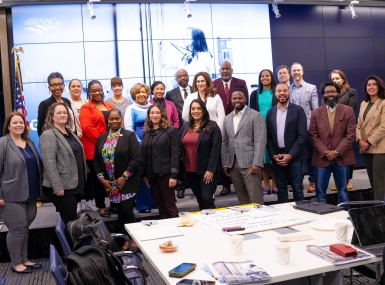Gender at Work
Author

Erika Philpot

Rose Winkeler
Upcoming Events
Related News
Drew, a county employee who works as a file clerk, is an efficient and hard-working employee. Drew also identifies as bi-gendered, meaning Drew has a gender identity that encompasses both genders. Sometimes Drew arrives at work as a male, sometimes as a female.
Gender: What once seemed very straightforward has become complex, confusing and controversial. As a result, county employers, like other employers across the country, are likely to face new questions as gender issues ripple across their workforce.
So, what do you as an employer need to know?
Drew may be considered gender non-conforming, which is a term for individuals whose gender expression is different from what society may expect from an individual of that sex. Drew’s co-workers may expect certain behaviors from Drew based on the name “Drew” or based on Drew’s gender expression at their first meeting. Being gender non-conforming might be new to them. Drew, though, has outstanding performance and has the right to be free from discrimination in the workplace.
People may express their gender in myriad ways, including through behavior or characteristics they do not intend to display at the office everyday. To avoid both legal challenges and an unwelcoming environment, a hiring manager cannot and should not inquire about gender expression in the interview process. After being hired, so long as an employee’s gender expression complies with a gender-neutral dress code, the manager should not discuss an employee’s gender expression.
How do employers ensure policies and procedures address transgender equality?
It is important to review your policy manual to identify whether any policies treat employees differently because of gender, such as a dress code policy or appearance/grooming standards policy. While an individual may be able to adapt attire to conform to the dress code policy, a grooming policy, which may address hair length for each gender, might not be as easily adaptable from day to day.
Also, to ensure equal treatment regardless of gender identity, and compliance with Title VII, employers should confirm any physical fitness standards required of new hires are non-gender specific. Additionally, consider whether there are positions within your agency that may require additional sensitivity to gender identity, such as a probation officer conducting urinalysis collection or a detention officer conducting a search. In the case of the probation officer conducting urinalysis, if the client has a nonconforming gender identity, it may be necessary for the employer to adjust the employee collecting the sample to match the gender of the client giving the sample. Are there processes, such as using a temperature strip instead of an observed sample that may alleviate the need for such gender specificity?
One of the most common themes in transgender discussions is bathroom usage. According to a March 7 CNN.com article, “as of March 2017, 19 states, the District of Columbia and more than 200 municipalities have anti-discrimination laws and ordinances allowing transgender people to use public facilities that correspond to their gender identity.” But not everyone agrees. Other states have enacted or are considering enacting laws that require individuals to use the restroom based on gender at birth rather than gender identity.
The heated national debate could cause employees to become very concerned about bathroom usage, while transgender employees might feel obligated to seek out the nearest single-user bathrooms.
An ideal solution is providing access to single-user, all-gender restrooms (sometimes also referred to as family restrooms). This could mean changes to your facilities, or, at a minimum, changes to signage. Further, some older buildings might not have single-user restroom design and the cost to construct such a restroom may be prohibitive. Still, single-user-family restrooms meet many needs. For example, they also provide a convenient way for a father to take a young daughter, or multiple children, to the rest-room, or to change a diaper at a changing station, without taking multiple children into the men’s room.
Your employer health plan is another area that may warrant review for nonconforming gender identity issues. The coverage of your employer health plan may seriously affect the ability of your transgender employees to obtain necessary medical care. Some health plans may contain exclusion wording such as “all procedures related to being transgender.”
According to Healthcare.gov, if a doctor determines that a preventive service is medically appropriate for a transgender individual and the individual meets the criteria for the recommendation as well as the coverage requirements, the plan must cover the service.
As always, employers should be aware of state laws that provide employer rights and responsibilities. But perhaps even more importantly, employers must try to set aside any personal or religious beliefs and continue to promote a culture free of harassment. Rebranding restrooms is one small part of a growing need for communication and education regarding changing laws and emerging terminology regarding transgender equality.
Recruiting and retaining efficient, effective, hard-working employees in a healthy, fair and tolerant workforce is good for employers and employees alike.
Attachments
Related News

DOJ issues final rule for state and local governments to implement web-based accessibility standards
On April 8, the U.S. Department of Justice (DOJ) announced the release of a web accessibility final rule for state and local governments.

County Countdown – April, 22, 2024
Every other week, NACo’s County Countdown reviews top federal policy advocacy items with an eye towards counties and the intergovernmental partnership.

Equity task force shares preliminary ideas for report
NACo's Equity + Governance Task Force is working to identify, prioritize and develop tools and resources counties need to advance equity in our communities.